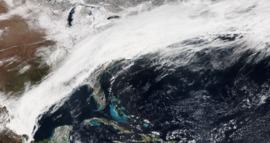Formed March 1, 2015 Dissipated 7 March 2015 | Lowest pressure 993 mb (29.32 inHg) | |
 | ||
Type Extratropical cyclone
Winter storm
Ice storm
Blizzard Maximum snowfall or ice accretion Snowfall – 54.6 in (139 cm) in Schofield Pass, Colorado
Ice – 0.25 in (6.4 mm) near Jackson, Mississippi Areas affected Southwestern United States, High Plains, Upper Midwest, Southeastern United States, Northern Mexico, Northeastern United States Affected areas Upper Midwest, Northeastern United States, Southwestern United States | ||
In the beginning of March 2015, a significant winter storm plowed through much of the United States, bringing 1–2 feet (12–24 in) of snow and record cold temperatures behind it. The storm actually occurred in two phases, with the latter bringing the cold temperatures behind it in its wake. Record cold temperatures even spread down to as far as northern Florida.
Contents
Meteorological history
The first phase of the storm came on March 2, as a vigorous area of low pressure formed along an arctic cold front. Drawing some moisture from the so-called "Pineapple Express" from the Pacific, snowfall began to develop in the Upper Midwest, spreading a swath of accumulating snow ranging from 3–6 inches (7.6–15.2 cm) into March 3. Snow began to push into the Northeast by the evening, with generally light accumulations, before tapering off and changing to rain showers later that night. As the initial area of low pressure moved into the northeastern parts of Canada, its cold front lingered, stretching from Maine to western Texas. Because of the "Pineapple Express" pumping moisture into just about the same area where this arctic front was set up, snow began to break out as a plume of precipitation began to take shape by mid-day on March 4. This was the start of the final phase of the winter storm. An icing threat also loomed ahead as well, stretching into the southwestern part of the Mid-Atlantic. A new area of low pressure then formed near the Arkansas–Louisiana border and began to track eastward. Rain changed to moderate snowfall by 1 a.m EDT March 5, as cold air began to sank in. A long swath of snow then began to stretch from the southeastern tip of Massachusetts, into New York City, all the way down to the northern parts of Mississippi. Snow from this system was that of the dry, fluffy kind, which was one reason power outages weren't so severe in the Northeast, however there was more in the ice portion of the storm. The storm continued to dump snow, ice and sleet across the eastern half of the United States, before moving off the coast late on March 5, leaving snow accumulations of 6–12 inches (15–30 cm) into the Northeast, and record cold in its wake, with some areas experience a near 50 °F (10 °C) drop in 24 hours as the arctic front moved through.
Snowfall totals
This is a list of the largest snowfall reports by state impacted by the storm. Source:
Travel
The winter storm snarled travel across many areas in the United States, including a massive pileup on Interstate 65 in Kentucky, in which some people were stranded on the highway for hours. Several other travel-related issues included a 14-car pileup on Interstate 459 in Alabama, a jackknifed semi and flipped snow plow in Washington D.C, a Delta plane traveling from Atlanta to New York City skidding off a snowy runway at LaGuardia Airport, and much more.
Records
Multiple records were set during and after the storm, with primary more after the storm had past.
Below is a list of records set during the winter storm. Sources:
